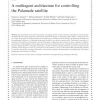Free Online Productivity Tools
i2Speak
i2Symbol
i2OCR
iTex2Img
iWeb2Print
iWeb2Shot
i2Type
iPdf2Split
iPdf2Merge
i2Bopomofo
i2Arabic
i2Style
i2Image
i2PDF
iLatex2Rtf
Sci2ools
WIAS
2010
2010
A multiagent architecture for controlling the Palamede satellite
The fundamental role of autonomous agents in managing activities of space systems has emerged some years ago with the NASA’s Remote Agent Experiment. However, the possible advantages of employing multiple agents to manage activities on a single space system are largely unexplored. This paper gives a contribution in this direction by presenting the design and the experimental validation of a multiagent architecture intended to run onboard a space satellite. Each agent is associated to a subsystem of the satellite and manages its activities. Each agent is organized in three modules, or layers: a planner, a scheduler, and an executor. Taken together across the agents, these layers form a distributed planner, a distributed scheduler, and a distributed executor, respectively. With a multiagent architecture, a number of benefits, including robustness, easy reuse of agents, and the possibility for the designer to focus on a small portion of the problem at a time, can be exploited. We exper...
| Added | 31 Jan 2011 |
| Updated | 31 Jan 2011 |
| Type | Journal |
| Year | 2010 |
| Where | WIAS |
| Authors | Francesco Amigoni, Stefano Gualandi, Daniele Menotti, Guido Sangiovanni |
Comments (0)

